The Apple iPad Mini 4 Review
by Brandon Chester on October 28, 2015 8:00 AM EST- Posted in
- Tablets
- Apple
- Mobile
- iPad Mini 4
System Performance
At this point the performance of Apple's A8 SoC is fairly well understood. There are some interesting changes to the version in the iPad Mini. The CPU has a peak clock speed of 1.5GHz, a 100MHz bump over the 1.4GHz A8 in the iPhone 6 and 6 Plus. The PowerVR GX6450 GPU should also have slightly higher clocks, as Apple states that the Mini 4 has 60% greater GPU performance than the Mini 2, while the iPhone 6 and 6 Plus were only advertised as being 50% faster than the iPhone 5s which used the exact same SoC as the Mini 2. Unfortunately it's still not clear exactly what clocks Apple has the GPU running at in any A8-based device. Finally, although the DRAM is not exactly part of the SoC itself, Apple is still using a package on package SoC/DRAM stack and has doubled the amount of DRAM to 2GB from the iPhone's 1GB.
While there won't be any massive gains over the CPU and GPU performance of the iPhone 6 and 6 Plus, the new A8 should provide some notable improvements over the iPad Mini 2 and 3. Relative to the iPad Air 2 performance should be similar in our JavaScript benchmarks, but there'll be a noticable gap in the the system and graphics sub tests in BaseMark OS II as they'll be able to fully take advantage of A8X's additional CPU core, cache, and much more powerful GPU.
Unfortunately we haven't actually had an iPad Mini 2 or an Air for some time now, and so I've decided not to include it in the charts as the results will no longer relevant or valid. Since we do have an iPhone 5s on hand I've used that as the point of comparison.


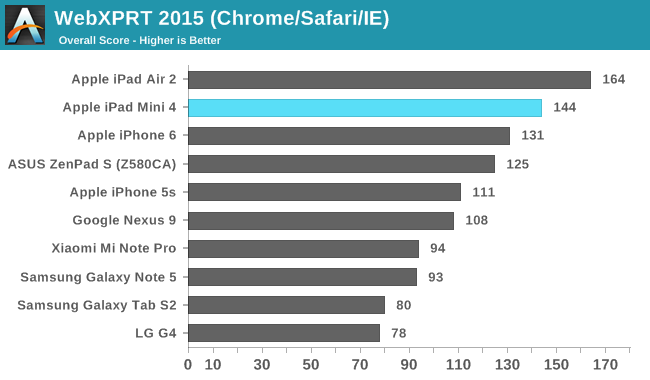
The interesting thing about JavaScript performance is that it's often bound by the performance of a single core. In this case the iPad Mini 4 does very well, and there's not a large gap between it and the iPad Air 2 despite the doubled L2 cache and additional core on the latter's A8X SoC. You certainly don't see anything even remotely close to a 50% lead for the Air 2 even though in a theoretical case where all cores are used entirely it would be 50% faster.

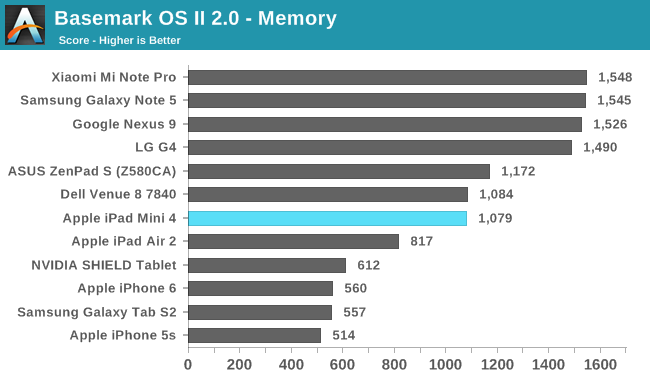
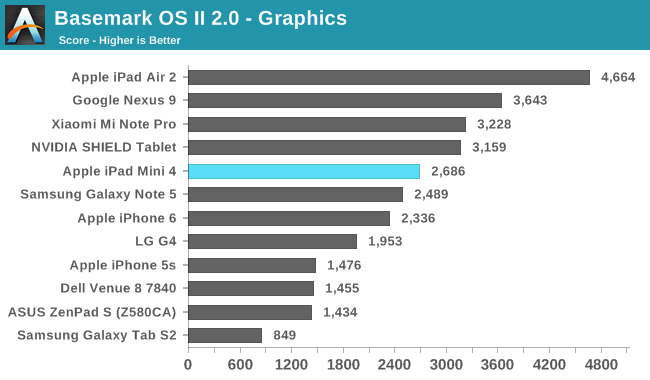
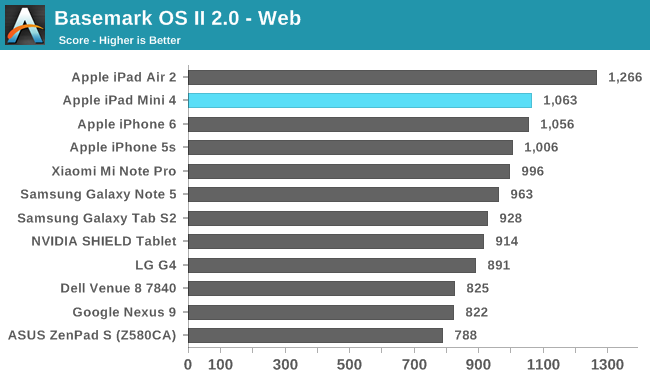
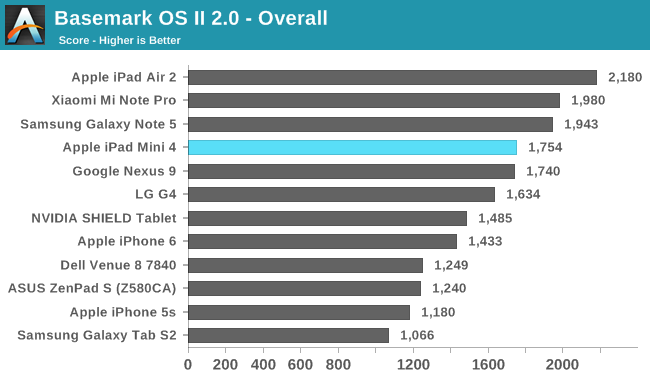
In BaseMark OS II's overall score the iPad Mini 4 is sitting right next to the Nexus 9, and both are relatively far below the iPad Air 2. However, it's important to analyze each sub test to see what areas a device excels at. Although it's right next to the Nexus 9 overall, the iPad Mini is significantly better in the system and web performance tests, while it falls behind in flash memory speed and graphics. Compared to the iPad Air 2 the Mini 4 falls behind in every test except for memory where it has a surprising lead. Looking at each test specifically, there's a tiny gap in web performance which echoes the results of our dedicated JavaScript benchmarks, and much larger gaps in system and GPU performance which makes sense as BaseMark OS II is designed in such a way that it will fully take advantage of A8X's triple core CPU and custom GXA6850 GPU in order to characterize their performance.
Overall I think the iPad Mini 4's general performance is right where it needs to be for a $399 small tablet. If you look at the results of the iPhone 5s you see that there is a significant gap between them in every test. The performance leap coming from the iPad Mini 3 certainly isn't like the leap that the original iPad Mini to iPad Mini 2 was when Apple moved directly from their A5 SoC to A7, but there's still a healthy improvement in performance across the board.
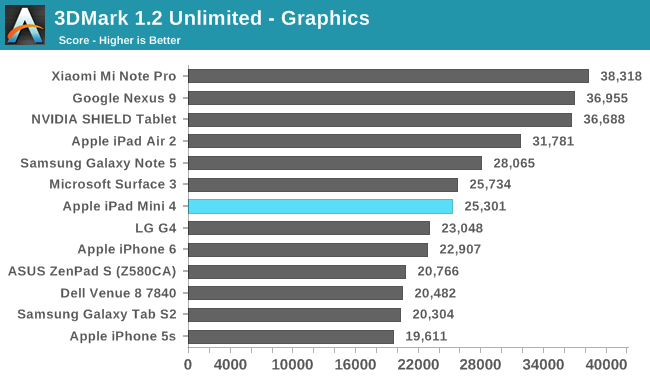

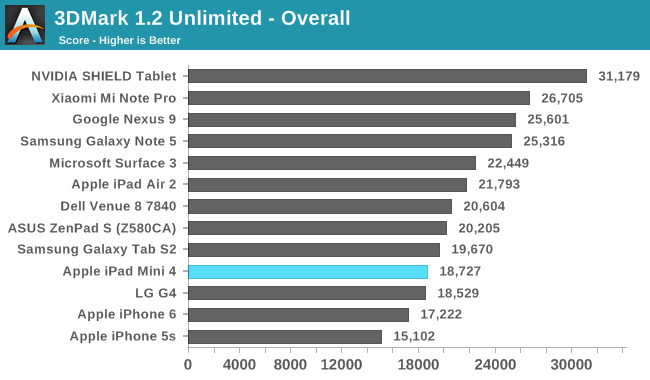
In 3DMark's overall score as well as both sub tests there's a small but noticeable gap between the Mini 4 and the iPhone 6. In the graphics test the Mini 4 is about 10% faster, while in the physics test the gap is a bit smaller at around 6%. The higher clocked CPU and GPU are definitely visible here, but the gap between the Mini 4's A8 SoC and the one in the iPhone 6 isn't enormous.
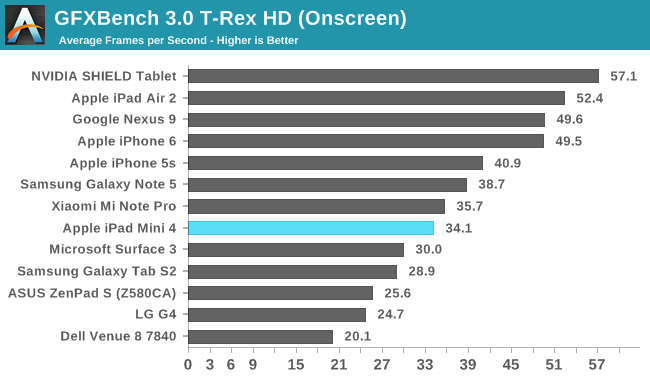
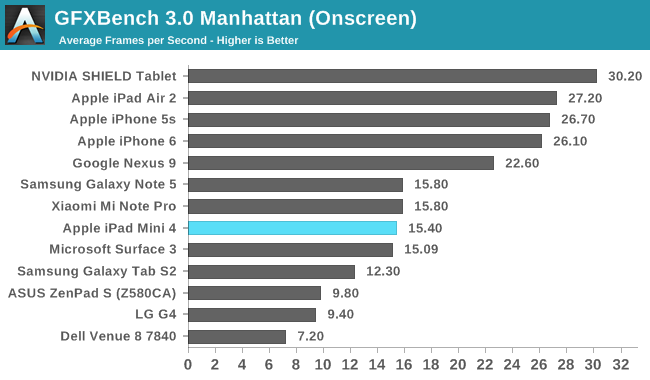
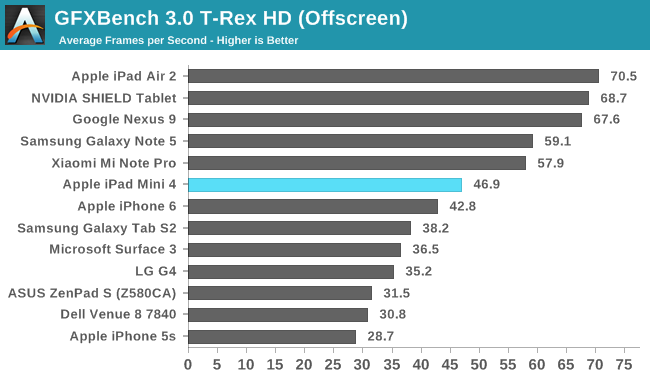

In GFXBench 3 the Mini 4 does pull ahead of the iPhone 6 when considering off screen 1080p performance, although with on screen performance the iPhone is much faster due to its lower resolution display. The level of graphical fidelity in the Manhattan benchmark is still too great to run consistently smoothly on the Mini at its native resolution, although a game with the visual quality of the T-Rex HD test would be playable at 2048x1536.
As I said earlier, the Mini 4's GPU performance is certainly not at the same level as the Nexus 9 or the iPad Air 2, but for a $399 8" tablet I think it's more than sufficient. One interesting point of comparison is the SHIELD Tablet, which was only $299 and has a very large lead over the Mini 4 as a result of its mobile Kepler GPU. It's also worth noting that while the Tab S2 model I reviewed was the 9.7" model, the 8.0" version should have identical results, and so the Mini 4 does have a decent lead over that. In the end the Mini 4 would have class-leading GPU performance if it weren't for the SHIELD Tablet, and NVIDIA definitely deserves credit for the level of GPU performance they were able to put into an 8" tablet. Even so, the Mini 4's GPU isn't going to have any trouble running the 3D apps or games on the App Store.
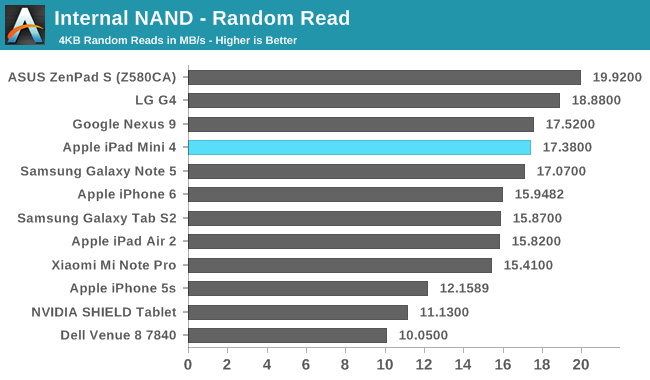
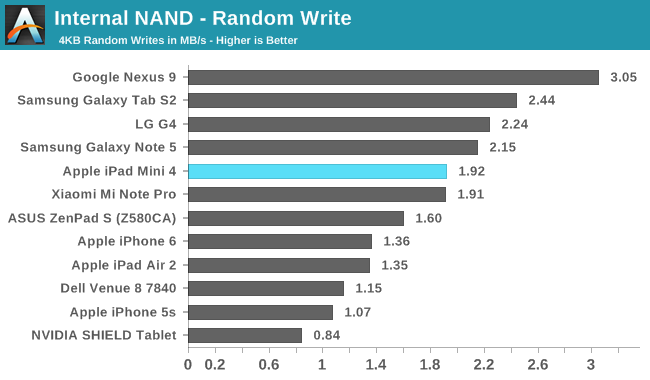
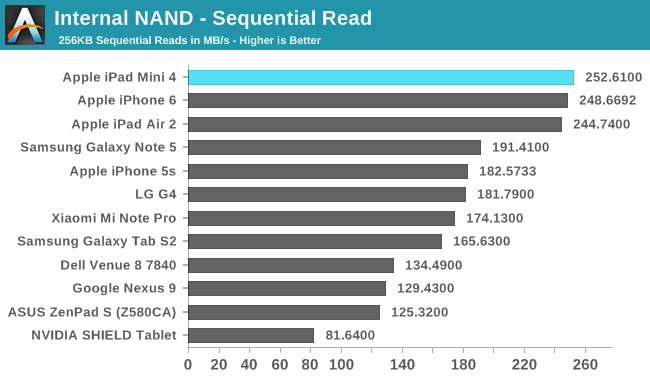
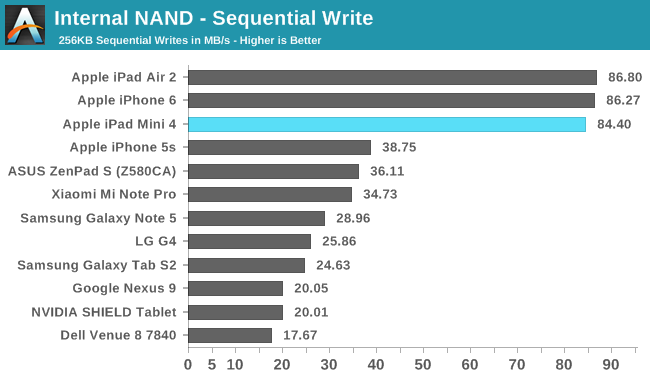
Storage performance on the iPad Mini 4 is where one would expect it to be. As usual, Apple excels when it comes to sequential reads and writes due to the use of SLC caching, with random read and write speeds also being very good, although not the best that we've seen on mobile devices. It's worth noting that my test model is a 128GB unit, and storage performance will be lower to some degree on the 64GB and 16GB models as flash storage uses parallelism heavily to improve performance by writing to multiple dies, and with a smaller storage capacity you have fewer dies to write to.










98 Comments
View All Comments
akdj - Sunday, November 1, 2015 - link
I meant to add the speed of the onboard storage and it's read write performance as well as the anti reflective coating, better color gamut and similar brightness with phenomenally accurate displays ...my guess is it's a power users dream to own a secondary display that is this mobile and this accurate with a gazillion apps that benefit the creative folkAnyway
Moving along
...there's more than just the 'A8' here that's in play and the iPod touch isn't much of a comparison.
osxandwindows - Friday, October 30, 2015 - link
No they could not produce more a9s then was necessary for the iPhones.denem - Saturday, October 31, 2015 - link
You have some inside information perhaps? The whole iPhone supply chain is set up to be able to meet demand.akdj - Sunday, November 1, 2015 - link
Hence the reason they're using two companies to fab their SoC this year? TSMC & Sammy? That's not tradition. It's very likely a contributing factorosxandwindows - Tuesday, November 3, 2015 - link
What did you want them to make 120 million of a9 chips?, come on dude even thats a hy number for samsung.akarogi - Wednesday, October 28, 2015 - link
If the iPad switch to match the ID of the iPhone 6, the rounded edges would render useless the multiple Keyboard or stand accessories that I've purchased. That hard edge on the iPad is important for stability, to be able to firmly catch the edge on whatever stand you're using.For example, the Microsoft Universal Mobile keyboard works well to prop up just about any device I own, except for the iPhone 6. The rounded edges catch just enough to hold it, but the slightest bump on the desk will send it crashing down.
Of course, manufacturers would just make new accessories for a new iPad ID, but I wonder if what I mentioned above factors into their decision to keep the existing ID. Having stability on a stand is much more critical for an iPad than for an iPhone, and iPad accessories on average will be a more significant monetary investment... so I'm quite glad my new Mini 4 still works on my keyboards and stands.
akarogi - Wednesday, October 28, 2015 - link
for example... think about how you would have to design a keyboard stand for an iPad with iPhone 6 industrial design, if you wanted to allow multiple viewing angles, like if you wanted to offer a 45-degree angle. With the rounded edges, this would be difficult to do without having a holding mechanism that needs to have a contact point far up onto the glass... basically the contact point would have to be right at the edge of where the screen starts. I don't think it would work unless they left a pretty decent flat margin between the edge of the device and the edge of the touchscreen.GC2:CS - Thursday, October 29, 2015 - link
The charge time for the iPad mini 4 looks really exciting, bassically on par with an iPhone 6 Plus (with an 5W adapter).It's better than any iPad ever cause if i remember corectly the iPad and iPad 2 got around 4 hours (10W ) the new iPad got over 6 (10W) the 4 get something like 5,5 (12W) and then Air got a much smaller battery and pushed down back to 4.
But please, from every source i can find, only the late 2012 iPad and iPad Air shipped with an 12W adapter and both mini 4 and Air 2 got the 10 W power adapter.
Can anandtech confirm this ? And does it mean there could be even a bit better charge times made with an 12W one ?
And then... what about the iPad pro ? Its got a 38,5 Wh cells which is bassically two iPad mini batteries stucked in there. So the big question is if it's going to ship with a 12W power adapter, or something higher. Like you know the Mac Book with it's 39,7 Wh battery got a 29W power adapter and I just feel thet iOS devices got behind in this area.
Would like to see some charging time data for the MacBooks.... to compare.
And the maybe even more important question to some, will this X-watt power adapter charge the smaller iPads even waster than the 12W one ?
Exchequer - Thursday, October 29, 2015 - link
Regarding that final tip. If you are a student and you need to create word documents then you will quickly find out that the default apps on IOS and Android do not support track changes. With a lot of searching I did find an app (Documents Ti Go) for Android and for IOS I never found one.So basically if you want to edit documents your best bet is a Surface (Pro) where you can just install the full office suite like you are used too.
kmmatney - Thursday, October 29, 2015 - link
I can't imagine being a student and creating word documents on a tablet, though. At least get a cheap laptop. Then again I was a college student before laptops existed, and was using a desktop with Windows 3.1 and dot matrix printer. Our track changes was "Save As...".